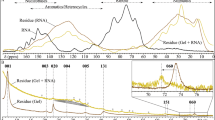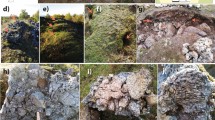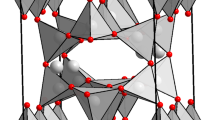Abstract
THE alteration of olivines by oxidation is well known in natural processes, and Haggerty and Baker1 have recently shown that it is primarily responsible for high temperature alteration in lavas. They carried out heating experiments in air on hand picked unaltered grains of composition 20 per cent fayalite (Fe2SiO4) at temperatures from 600°–1,000° C. We have made similar investigations on various members of the forsterite–fayalite series over a wider temperature range with a view to defining the structural changes that take place in the oxidative breakdown of an olivine and to establish the atomic mechanisms responsible. Our experiments, using X-ray single-crystal and powder methods, infrared spectroscopy and electron optical and diffraction techniques, reveal complexities not mentioned by Haggerty and Baker.
This is a preview of subscription content, access via your institution
Access options
Subscribe to this journal
Receive 51 print issues and online access
$199.00 per year
only $3.90 per issue
Buy this article
- Purchase on Springer Link
- Instant access to full article PDF
Prices may be subject to local taxes which are calculated during checkout
Similar content being viewed by others
References
Haggerty and Baker, I., Contrib. Mineral. Petrol., 16, 233 (1967).
Gay, P., and Le Maitre, R. W., Amer. Mineral., 46, 92 (1961).
Kachi, S., Momiyama, K., and Shimizu, S., J. Phys. Soc. Japan, 18, 106 (1963).
Author information
Authors and Affiliations
Rights and permissions
About this article
Cite this article
CHAMPNESS, P., GAY, P. Oxidation of Olivines. Nature 218, 157–158 (1968). https://doi.org/10.1038/218157a0
Received:
Issue Date:
DOI: https://doi.org/10.1038/218157a0
This article is cited by
-
Oxidation of natural olivines
Nature (1974)
Comments
By submitting a comment you agree to abide by our Terms and Community Guidelines. If you find something abusive or that does not comply with our terms or guidelines please flag it as inappropriate.



